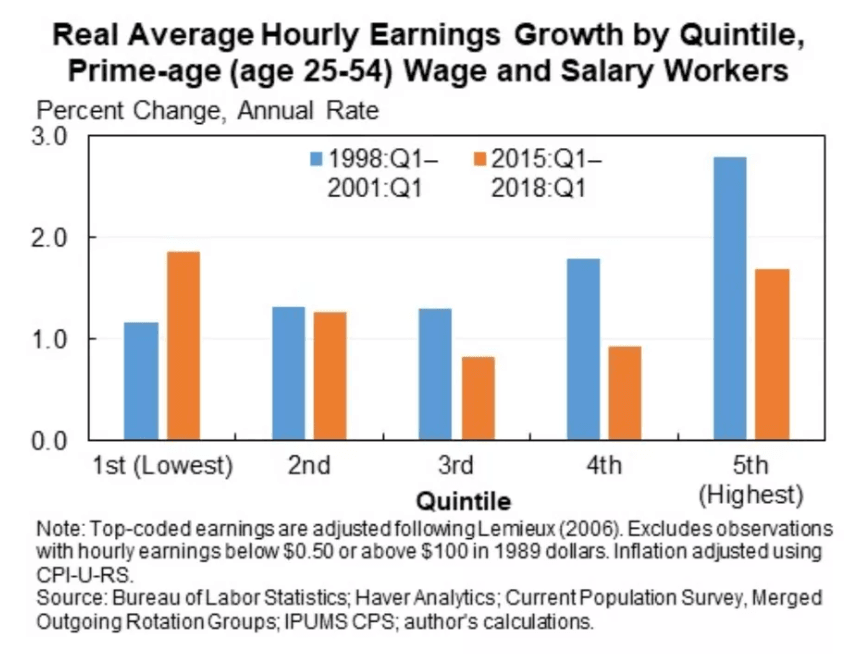President Donald Trump has shifted the economy so that once-disregarded blue-collar manufacturing workers are now recovering jobs faster than coastal service-sector employees, the Washington Post acknowledged Sunday.
“Blue-collar jobs are growing at their fastest rate in more than 30 years, helping fuel a hiring boom in many small towns and rural areas that are strong supporters of President Trump ahead of November’s mid-term elections,” said the Post, under the headline “Under Trump, the jobs boom has finally reached blue-collar workers. Will it last?”
According to the Post:
Rural employment grew at an annualized rate of 5.1 percent in the first quarter. Smaller metro areas grew 5.0 percent. That’s significantly larger than the 4.1 percent growth seen in large urban areas that recovered earlier from the Great Recession, according to an analysis by the Brookings Institution’s Metropolitan Policy Program of a separate set of Labor Department data released on Wednesday.
In the past year, the economy has added 656,000 blue-collar jobs, compared to 1.7 million added in the services sector. But the rate of growth in blue-collar jobs is speeding up, while service-sector job growth has hovered around 1.3 percent over the past year.
The New York Times is also admitting that Trump’s economic policies are reaching people outside the Democratic Party’s base of coastal cities — and is also saying pay raises could soon rise faster because companies and investors have run out of alternatives. On Sept 7, the Times reported:
The headlines for the August job numbers released this morning are nothing but good. Employers added a robust 201,000 jobs, the unemployment rate remained at the rock-bottom level of 3.9 percent, and wages grew the fastest they have in nine years.
There’s no doubt that this is the best economy in quite a long time for American workers, who by a wide range of measures can find a job more easily than they have in a decade …
But the fact that higher pay raises are finally showing up in the data is another piece of evidence that employers are coming up against the limits of the labor force. Just maybe, after years of trying every recruitment technique other than raising hourly pay, employers are starting to turn more to that option.
Trump’s economic promises to aid the manufacturing sector were ridiculed before and after the election by the Democratic Party’s progressive elite.
Throughout President Barack Obama’s term, the progressive elite steered opportunities and wealth away from manufacturing sectors, which were deemed to be bad for the environment but ideal for relocation via free-trade deals to China and other Asian economies. The progressives also steered wealth, government spending, and social status towards their service-sector supporters in wealthy coastal cities and in post-graduate career slots. For Obama, Obama repeatedly praised Silicon Valley CEOs, teachers, students, environmentalists, as well as “community organizers.”
Under Trump, however, the economy’s gains are being spread more evenly throughout the nation and across the workforce.
For example, President Barack Obama’s top economic advisor, Jason Furman, posted a chart showing that lower-income workers are seeing the greatest gains:
Neither of the two articles in the Washington Post or the New York Times recognized any role for Trump’s low-immigration/high-wages policy, even though it has modestly reduced the inflow of cheap-labor migrants and penalized companies who hire illegal immigrants.
Trump has also pressured U.S. companies to reduce outsourcing of middle-class jobs via the H-1B and other visa-worker programs which have helped keep salaries flat for many college-graduates for at least two decades.
But Trump’s rising pressure for popular pay-raises before the 2018 election is prompting business groups to step up their lobbying for quick access to more foreign workers.
Business-first GOP Rep. Kevin Yoder added four cheap-labor programs to the 2019 spending plan for the Department of Homeland Security, in the hope that Trump will approve those cheap-labor programs in exchange for extra spending on the border wall.
The Kansas representative’s four-part cheap-labor plan was endorsed by nearly all GOP members on the House appropriations committee in July and likely was backed by GOP leaders.
The middle-class “country caps” outsourcing bill was endorsed by Amazon, IBM and the billionaire founders of FWD.us, partly because it helps many investors continue replacing American graduates with cheap foreign graduates. Yoder says his bill would end discrimination, but it is backed by many business lobbyists and critics say it will boost discrimination against Americans.
Those cheap-labor programs must be stripped from Yoder bill before the election, said RJ Hauman, policy director at the Federation for American Immigration Reform. “We fear the president will sign something [after the election] that does contain that border wall funding despite the other things in it that fly in the face of his agenda,” he said.
Overall, the Washington-imposed economic policy of economic growth via immigration shifts wealth from young people towards older people by flooding the market with cheap foreign labor.
Four million young Americans will join the workforce this year, but the federal government will also import 1.1 million legal immigrants, and allow an army of at least 2 million visa-workers to work U.S. jobs.
That process spikes profits and Wall Street values by cutting salaries for manual and skilled labor offered by blue-collar and white-collar employees. The policy also drives up real estate prices, widens wealth-gaps, reduces high-tech investment, increases state and local tax burdens, hurts kids’ schools and college education, pushes Americans away from high-tech careers, and sidelines at least 5 million marginalized Americans and their families, including many who are now struggling with opioid addictions. Immigration also pulls investment and wealth away from heartland states because investment flows towards the large immigrant populations living in the coastal states.


COMMENTS
Please let us know if you're having issues with commenting.